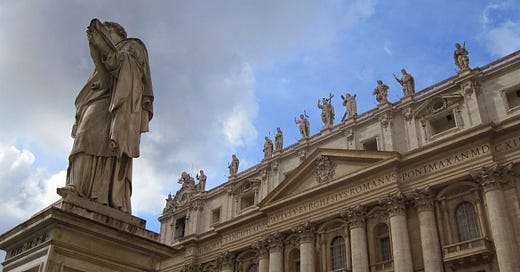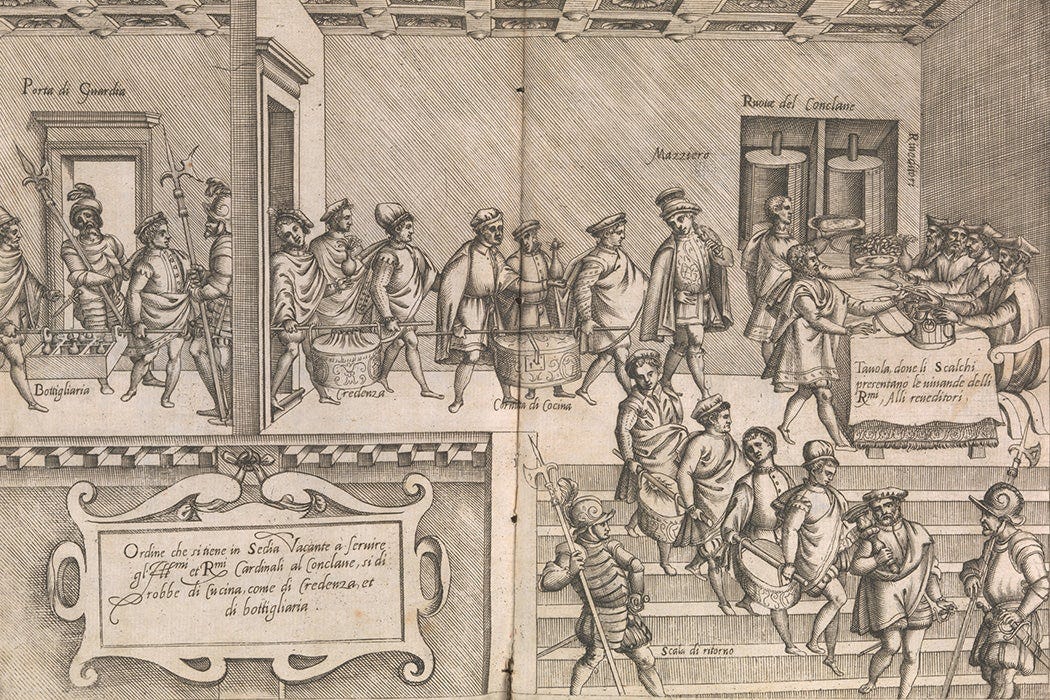The Renaissance Papal Conclave: What Did They Eat?
Plus win a copy of Paulette Kennedy's latest Gothic thriller!
On the way to Rome last month I had the opportunity to watch the movie Conclave, which was absolutely excellent. The timing of that movie couldn’t have been better considering that it came out right before the death of Pope Francis. Since his passing, the movie viewership has soared as people seek to understand what exactly happens when a pope dies.
And of course, you can’t talk about any conclave without getting the Sistine Chapel involved. I have had the great fortune of seeing it several times (although I’m more awed by the nearby Raphael rooms) but my favorite time was in 2021, right after the vaccines became available and few people were traveling. Never again will I see so few people in this space. Also, the guards didn’t yell at me for taking these photos, which was a total shock.
The movie Conclave will give you a sense of how a modern conclave goes down, but let’s go back in time to when the world first learns what happens behind those closed doors.
The focus of my second novel, The Chef’s Secret, is Bartolomeo Scappi, who was the cuoco segreto to several Popes. It's because of him that we know what a Renaissance conclave was like; after all, he had to prepare the food for all of the voting Cardinals. Fortunately he wrote it all down in his massive cookbook, first published in 1570, called "The Opera of Bartolomeo Scappi." Opera in Italian essentially means "work" or "body of work." You can view a digital archive of his original cookbook on the Internet Archive.
What happens in a papal conclave?
When the Pope dies (or in Pope Benedict's case, resigns), and after the funeral and many ceremonies related to the death of that Pope, all the Cardinals file into the Sistine Chapel and the doors are barred behind them. An area adjoining the Chapel is turned into housing with individual cells for each Cardinal. There are a limited number of servants and officials allowed into the conclave, a number that has varied over the years. In modern times they also background check those individuals and sweep the Chapel for bugs so that the outside world does not know about the proceedings. The Cardinals debate and ponder and every day they cast a vote as to which Cardinal should become Pope. They stay in the conclave until a 2/3 vote is reached. Conclaves can take days, weeks, months or in some cases, even years.
In medieval times some restrictions were set to help push the process along.
"In an attempt to avoid future lengthy elections, Gregory X introduced stringent rules with the promulgation of Ubi periculum. Cardinals were to be secluded in a closed area and not accorded individual rooms. No cardinal was allowed, unless ill, to be attended by more than two servants. Food was supplied through a window to avoid outside contact. After three days of the conclave, the cardinals were to receive only one dish a day; after another five days, they were to receive just bread and water. During the conclave, no cardinal was to receive any ecclesiastical revenue."
By the time of Scappi these rules had mostly been abolished, probably because it resulted in hasty decisions.
So what happened in a Renaissance Papal conclave?
In his Opera, Scappi describes the papal conclave of Paul III. He tells us that 59 cells were prepared for the Cardinals (several left sick and died before the conclave was complete) and they began entrance into the conclave on November 29th, 1549. It lasted until February 7, 1550. Scappi tells us of the cells, that they were 16 1/2 square, that they were decorated with cushions, bed sheets, mattresses and pillows all the color purple. They had a chamber pot, two stools a table, and other necessities, all decorated with purple. They also had a hamper, which Scappi describes in detail, for the transport of their food by servants from the kitchen to the cells (p.622). Everything was decorated with the Cardinal's specific coat of arms.
Each day the Cardinals were chosen by lot as to who would be served their food first. Scappi gives us more details:
The Lord Stewards, as I said, had a hamper for the kitchen food and a tub for the credenza food, and they served that way. To begin with, each Steward had, in those two containers, carefully prepared and arranged every item of food — the normal credenza having been carried out by the Assayer, Cook, CeIlarer, Charcutier and others who might have been involved in the handling of the food. His Mace Bearer with his Most Reverend master’s Mace would lead off, followed by two Footmen with two staves painted the same colour as the hamper. Then came the Steward with four or six squires who bore carafes full of all sorts of wine and pure water; among them walked the Cellarer carrying a small carafe of wine; the carafes were all covered with oranges or flowers, and had labels on which the variety and quality of the wines were written. Then came two Footmen bearing the large tub with the Credenza foods. Then there followed the Assayers with two other Footmen carrying the hamper. After them and accompanying the prepared dishes came a few nobles, too, of that Most Reverend Cardinal. When the Steward was sent, as was said, to the place where things were served up, he finds at the first grille the guard of the Lord Magistrates; right by the end of the two staircases, he finds the Italian guards and the Swiss Guards; he goes along the corridor where there is another grille with two gateways, one to enter by for serving, the other to come out by after having served. As he goes in through that grille there is another Italian guard and Swiss Guard who open and close; here the two Messengers (as I have said) who, following the order on the list, summon the Stewards. Just past the grille there is a table fifteen hands long and about four hands deep. When the Steward reaches it he takes a very white napkin from the Assayer; in front of the aforementioned four Bishops another napkin is spread out with two knives and a fork which those Reverend Prelates would take, and he immediately presents himself along with the squires, handing over the carafes of wine and water and removing from his tub the several sorts of salad, fruit and other things needed [f. A4r] (translation by Terrance Scully)
Scappi goes on to say that closed pies, whole chickens and other similar dishes were not allowed (too easy to include secret missives and bribes on how to vote). All food was thoroughly checked by special officials within the conclave. Wine was only allowed in open glasses, not closed vessels. When food was leftover it was distributed among the servants within.
Scappi also tells us about the changing of the guard, which Cardinals fell ill and left the conclave and other assorted details. There is even a plate within the book that shows what the hampers looked like!
What did Renaissance Cardinals eat when locked in a Papal conclave?
He doesn't tell us exactly what he served them, but we can guess based on the recipes he left within the Opera.
The Cardinals may have had pasta, including ravioli and rabbit parpadelle. Those hampers may have been carefully packed with cheesy breads, veal croquettes, roasted bear, grilled beef ribs, open faced mushroom crostatas, pheasant in red-currant sauce, and maybe even caviar omelets (made with cinnamon, sugar, orange juice and pepper). Eels cooked in wine, fried anchovies and razor clams, roasted broccoli, stuffed eggs and chickpea fritters may also have filled the Cardinal's bellies. Scappi even had recipes for early Neapolitan pizza, which were sweet, made of almonds, raisins, dates, figs, eggs and rosewater cooked on a flat, flaky pastry round. It was served hot or cold, just like pizza is enjoyed today. A variety of cold dishes were packed in the hampers since the hamper could only go into the conclave once a day.
The end of the conclave
The end of a conclave today is likely very similar to the way it ended in Scappi's time. After all the votes on each day, smoke is released from a chimney in the conclave. If the smoke is dark (made by throwing damp straw into the flames), then a new Pope has not been chosen. White smoke, however, signals that there is a new Pope.
At the end of the Conclave that Scappi describes that, at ten o'clock in the evening of November 29, 1549, the white smoke was released, announcing the choice of a new Pope, Giovanni del Monte, who chose to go by the name of Julius III.
I wonder if the Cardinals who convene on March 7th will be eating as well as those who chose Pope Julius did.
You can learn more about the world of the Renaissance popes and cardinals in my novel, The Chef’s Secret.
WIN A COPY OF THE ARTIST OF BLACKBERRY GRANGE
The Artist of Blackberry Grange by Paulette Kennedy is absolutely riveting. I've loved her previous novels, but this one might be her most affecting and intimate yet. The blend of grief, memory, and spectral mystery is so skillfully rendered that Blackberry Grange feels like a character in its own right—its walls pulsing with regret and longing. Sadie’s journey is achingly human, and Marguerite’s unraveling is both terrifying and tender. Kennedy’s prose is as evocative as ever, and the way she weaves supernatural elements with the raw complexities of caretaking and familial legacy left me deeply moved. God, I can't wait for her next book.
For a young caregiver in the Ozarks, an old house holds haunting memories in a ghostly novel about family secrets, sacrifice, and lost loves by the author of The Devil and Mrs. Davenport.
In the summer of 1925, the winds of change are particularly chilling for a young woman whose life has suddenly become unbalanced.
Devastated by her mother’s death and a cruel, broken engagement, Sadie Halloran learns that her great-aunt Marguerite, a renowned artist now in the throes of dementia, needs a live-in companion. Grasping at newfound purpose, Sadie leaves her desolate Kansas City boardinghouse for Blackberry Grange, Marguerite’s once-grand mansion sitting precariously atop an Arkansas bluff. Though Marguerite is a fading shell of the vibrant woman Sadie remembers, Marguerite is feverishly compelled to paint eerie, hallucinatory portraits of old lovers―some cherished, some regretted, and some beastly. All of them haunting.
With each passing night, time itself seems to shift with the shadows at Blackberry Grange. As truth and delusion begin to blur, Sadie must uncover the secrets that hold Marguerite captive to her past before reality―and Marguerite’s life―slips away entirely.
Do you want to win this book?
This giveaway closed at midnight ET on Wednesday, 05/07/25. Winners will be notified within 48 hours of the giveaway closing and announced in my future newsletter/post.
Important to Note: You must be 18+ and a United States resident (pesky international laws make it tricky to do giveaways worldwide). If you are someone who loves to read the rules, you can find the obligatory info here.
What’s Bringing Me Joy This Week
I love Eva Calvani’s Instagram. She is hilarious and showcases the funny things about Italians, Italy and the language. Also, my comment scored over 2.8K likes so I briefly feel like a winner.
Thanks for Joining Me
If you love food and love Italy, and haven’t read IN THE GARDEN OF MONSTERS, THE CHEF’S SECRET or FEAST OF SORROW, click the links to learn where to buy your copy! And now you can pre-order my latest, THE HAPPINESS COLLECTOR!
You can also follow me here: Website | Instagram | Facebook | Threads | Bluesky











